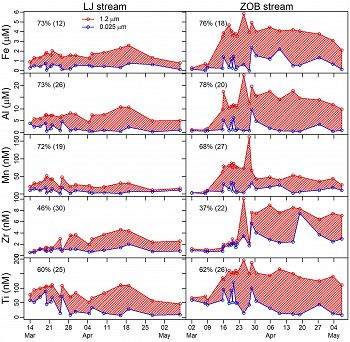Olshansky et al., 2018
Subsurface Pore Water Contributions to Stream Concentration-Discharge Relations Across a Snowmelt Hydrograph
Olshansky Y., White A.M., Moravec B.G., McIntosh J., Chorover J. (2018)
Frontiers in Earth Science 6: 181
-
Catalina-Jemez, GRAD STUDENT
-
Catalina-Jemez, GRAD STUDENT
-
Catalina-Jemez, INVESTIGATOR
-
Catalina-Jemez, INVESTIGATOR
Abstract
Time series results for the cascade filtration data pertaining to Fe, Al, Mn, Zr, and Ti. Concentrations are shown for elements in filtrates following filtration at 1.2 μm (red) and 0.025 μm (blue). Area marked in red diagonal lines represents the elemental mass contribution of colloids (0.025–1.2 μm). Numbers inset in each plot are the mean and standard deviation of the colloidal fraction over the course of the experiment.
This study investigated the concentration discharge (C-Q) patterns of selected elements transported to streams during spring snowmelt through an instrumented mixed-conifer forested catchment in rhyolitic terrain in the Jemez Mountains (NM, USA). High frequency, concurrent sampling of soil solution and gases, groundwater, and surface water enabled identification and sourcing of five groups of solutes with distinct C-Q behavior. Non-hydrolysing cations and strong acid anions, had mostly positive C-Q relations and a clockwise hysteresis pattern related to flushing of a limited reservoir of solutes accumulated in soils under snowpack. Rare earth elements (REEs) and dissolved organic carbon (DOC), demonstrated large positive C-Q relations and a clockwise hysteresis pattern, consistent with their co-transport as metal-ligand complexes, and signaling bio-weathering reactions in the soil. Silicon and dissolved inorganic carbon (DIC) exhibited chemostatic C-Q trends and an anti-clockwise hysteresis pattern consistent with sourcing from deep groundwater. Hydrolyzing metals (Mn, Al, Ti and Zr) with high coefficients of variance (CV) for concentration relative to CV values for stream discharge and with no significant C-Q pattern, were found to be transported mainly as filterable colloids. Fe C-Q behavior was similar to this hydrolyzing metals group, but complexation with DOC was also important for Fe during the initial stage of the snowmelt hydrograph. Investigation of time-series of solutes and gases provided evidence for biologically-induced silicate weathering reactions that initiated in the soil subsurface and propagated down through groundwater to streams.
Key Points
- Hydrologic and critical zone observatories provide opportunities for high frequency sensing and sampling to resolve coupled processes controlling catchment hydrochemical response.
- Cluster and principal components analysis of indices pertaining to concentration-discharge (C-Q) identified five groups of solutes with transport behavior governed by distinct hydrogeochemical processes.
- The results provide evidence of biologically influenced weathering reactions in soil and groundwater time-series that are propagated into stream C-Q relations.
Citation
Olshansky Y., White A.M., Moravec B.G., McIntosh J., Chorover J. (2018): Subsurface Pore Water Contributions to Stream Concentration-Discharge Relations Across a Snowmelt Hydrograph. Frontiers in Earth Science 6: 181. DOI: 10.3389/feart.2018.00181
 This Paper/Book acknowledges NSF CZO grant support.
This Paper/Book acknowledges NSF CZO grant support.
Explore Further





